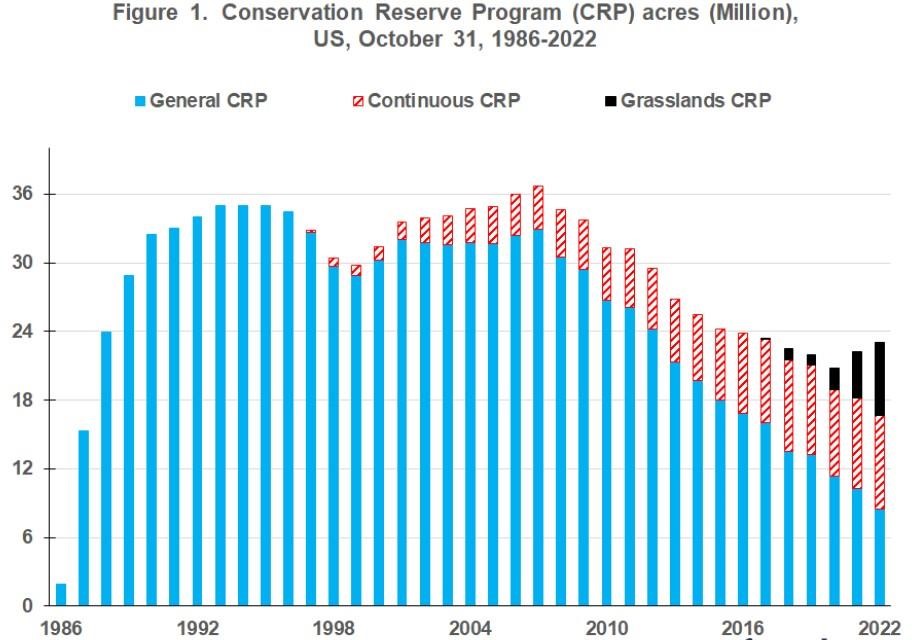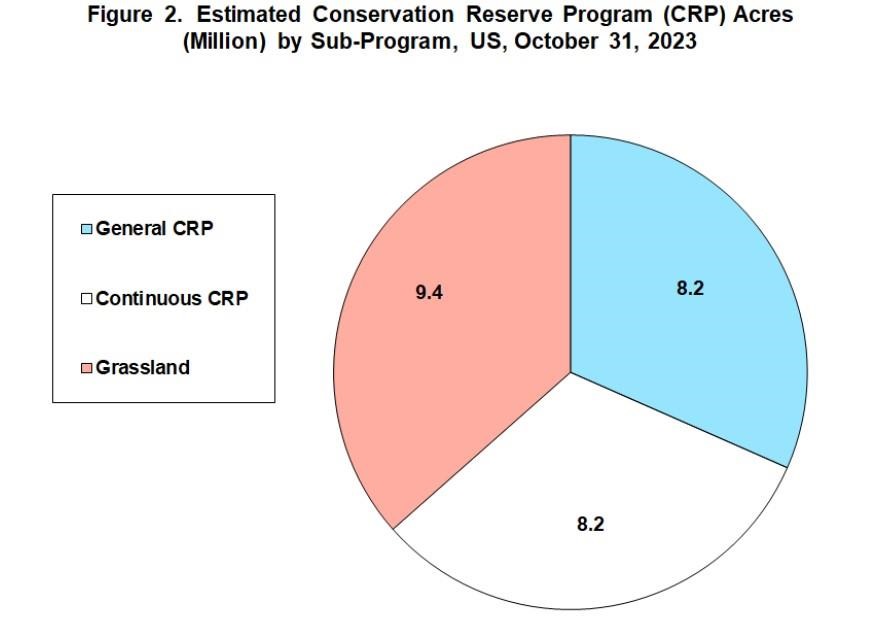The new farm bill presents a generational opportunity to repurpose CRP (Conservation Reserve Program). CRP’s historic focus on removing whole fields and farms from production, denoted General CRP, will almost certainly cease to be the largest CRP program in 2023. This transformation, plus advances in GPS (Global Positioning Systems) and farm tillage as well as strong returns to producing crops since 2007, suggest it is time to merge General CRP and Continuous CRP into a Site Specific CRP. Similar to Continuous CRP, Site Specific CRP would emphasize identification of sites in a field with the highest benefit-cost ratio for improving environmental quality while keeping the rest of the field in farm production. In addition, a Carbon Capture CRP, built around Grassland CRP, would give CRP a prominent role in utilizing working agricultural lands to meet a contemporary environmental need.
Evolution of CRP
General CRP was the only CRP program until September 1996 when Continuous CRP was created administratively using General CRP authority. General CRP acres peaked at 35.0 million in 1993-1995, declining to 8.3 million at the start of the 2022 CRP year in October (see Figure 1). Over 90% of this decline has occurred since 2006 during a period of generally high market returns for crops. Continuous CRP acres increased as General CRP acres declined until 2018. They have remained around 8 million since. Grassland CRP was created when the 2014 farm bill moved the Grassland Reserve Program (GRP) created by the 2002 farm bill into CRP. Grassland CRP is a working lands program. It allows grazing while pursing environmental benefits and protecting grasslands. Acres in Grassland CRP more than tripled from 1.8 to 6.3 million between October 31, 2020 and 2022. Program changes enhanced its attractiveness, including a $15 minimum per acre payment that is favorable vs. pasture rental rates. CRP enrollment acres are from USDA, FSA (US Department of Agriculture, Farm Service Agency). For more detailed discussion of CRP and its evolving mission, see the October 25, 2021 and February 17, 2022 farmdoc dailies.

RP 2023
Results of the 2023 General and Grassland CRP sign-ups have been released. A total of 3.11 million acres were accepted into Grassland CRP (USDA, FSA, April 17, 2023). For General CRP, offers of 0.30 million new acres and 0.89 million expiring contract acres were accepted (USDA, FSA, June 12, 2023). An owner can decide not to enroll accepted acres. Acres can be enrolled in Continuous CRP at any time. Acres under contracts expiring on September 30, 2023 total 1.5 million in General CRP and 0.47 million in Continuous CRP (USDA, FSA, July 2023). If we assume (1) May 31, 2023 CRP acres as the starting point, (2) all accepted acres will enroll in CRP by September 30, 2023, and (3) all expiring Continuous CRP acres will reenroll; Grassland CRP will have the most acres at 9.2 million by October 31, 2023 (see Figure 2). General and Continuous CRP will each have 8.2 million acres. For the first time, General CRP will likely not be the largest CRP program.

Discussion
CRP has evolved into a program distant from its original design. Its historic objective to remove whole fields from production will be surpassed by Grassland CRP as the largest CRP program in 2023. Moreover, Continuous CRP will be as large as General CRP.
The on-going shift in CRP acres, profitability of crop production since 2006, and improvements in GPS combine to prompt a fundamental policy design question: “Should General and Continuous CRP be folded into a Site Specific CRP?” Whole field removal would occur only if its benefit-cost ratio exceeds that of site specific environmentally beneficial practices with the rest of the field in crop production. This proposal builds upon the idea of Precision Conservation (see Swinton, 2022).
The increasing role of grasslands in CRP, research that suggests sequestration of carbon by pastures can be increased (Conant, et al., 2017; and Paustian, et al., 2019), and the 400 million plus acres of non-forested grazing land in the US (USDA, NASS, April 2019) also combine to prompt a fundamental policy design question: “Should a Carbon Capture CRP program be created with Grassland CRP as a component?” Proposals also exist to focus a Carbon Capture CRP on forest land (see, for example, Lichtenberg, July 5, 2023). According to the 2017 Census of Agriculture, there are 73 million acres of woodlots on farms. USDA, FSA currently supports a research project to better quantify carbon capture by perennial grasses, trees, and wetlands (USDA, FSA, October 12, 2021).
A Carbon Capture CRP initially focused on grasslands may offer more potential to capture carbon than the much debated, currently unproven carbon markets for the 318 million acres of principal crops in the US.
Source : illinois.edu